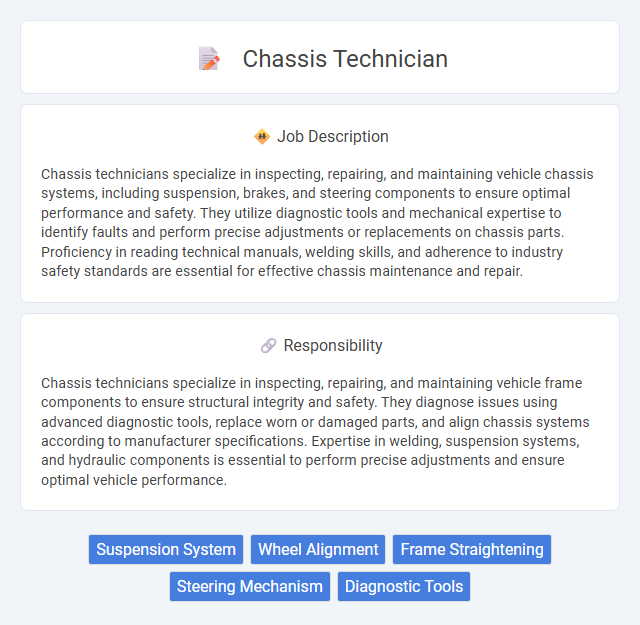
Chassis technicians specialize in inspecting, repairing, and maintaining vehicle chassis systems, including suspension, brakes, and steering components to ensure optimal performance and safety. They utilize diagnostic tools and mechanical expertise to identify faults and perform precise adjustments or replacements on chassis parts. Proficiency in reading technical manuals, welding skills, and adherence to industry safety standards are essential for effective chassis maintenance and repair.
Individuals who possess strong physical stamina and manual dexterity are likely to be well-suited for a chassis technician role. Those with a keen eye for detail and an interest in automotive mechanics may find the job both engaging and fulfilling. Candidates who struggle with repetitive tasks or physical labor might face challenges in adapting to the demands of this position.
Qualification
Chassis technicians require a high school diploma or equivalent, often supplemented by specialized technical training or certifications in automotive technology. Proficiency in diagnosing and repairing vehicle suspension systems, steering components, and brake assemblies is essential, along with hands-on experience using diagnostic equipment and tools. Strong mechanical aptitude, attention to detail, and the ability to interpret technical manuals and schematics significantly enhance job performance and employability.
Responsibility
Chassis technicians specialize in inspecting, repairing, and maintaining vehicle frame components to ensure structural integrity and safety. They diagnose issues using advanced diagnostic tools, replace worn or damaged parts, and align chassis systems according to manufacturer specifications. Expertise in welding, suspension systems, and hydraulic components is essential to perform precise adjustments and ensure optimal vehicle performance.
Benefit
A chassis technician role likely offers a range of benefits including competitive salary packages and opportunities for skill advancement through hands-on experience with vehicle frame repairs and maintenance. Employees may gain access to health insurance, retirement plans, and paid time off, contributing to job security and well-being. The position might also provide chances for career growth within the automotive repair industry, enhancing long-term professional prospects.
Challenge
Chassis technicians likely face the challenge of diagnosing complex structural and suspension issues that require precise technical knowledge and hands-on expertise. The probability of encountering unexpected mechanical failures means technicians must continuously adapt and learn evolving automotive technologies. These challenges demand a high level of problem-solving skills and attention to detail to ensure vehicle safety and performance.
Career Advancement
Chassis technicians focusing on advanced diagnostics and repair techniques can rapidly progress to senior roles or specialized fields such as suspension systems and frame alignment. Gaining certifications from recognized automotive organizations enhances credibility and opens doors to supervisory or training positions. Mastery of the latest automotive technologies and continuous skill development significantly improves career growth opportunities in the chassis repair industry.
Key Terms
Suspension System
Chassis technicians specialize in inspecting, repairing, and maintaining vehicle suspension systems to ensure optimal performance and safety. They diagnose issues with components such as shock absorbers, struts, control arms, and springs, using advanced diagnostic tools and equipment. Expertise in suspension alignment, balancing, and component replacement is essential for minimizing vehicle wear and enhancing ride quality.
Wheel Alignment
Chassis technicians specializing in wheel alignment diagnose and adjust vehicle suspension components to ensure optimal tire contact with the road, enhancing safety and performance. They utilize advanced alignment machines and diagnostic equipment to measure camber, caster, and toe settings with precision. Expertise in wheel alignment reduces tire wear, improves fuel efficiency, and enhances overall vehicle handling.
Frame Straightening
A Chassis Technician specializes in frame straightening to restore vehicle structural integrity after collisions. Using advanced measuring systems and hydraulic machines, they precisely realign the chassis to factory specifications, ensuring safety and proper handling. Expertise in welding, metal fabrication, and damage assessment is critical for effective frame repairs and optimal vehicle performance.
Steering Mechanism
Chassis technicians specialize in repairing and maintaining the steering mechanisms of vehicles, ensuring precise control and safety. They diagnose issues with components such as steering racks, tie rods, and power steering systems using advanced diagnostic tools. Expertise in hydraulic and electric steering systems allows chassis technicians to restore optimal vehicle handling and alignment efficiently.
Diagnostic Tools
Chassis technicians utilize advanced diagnostic tools such as scan tools, oscilloscopes, and laser alignment systems to accurately identify and troubleshoot issues in vehicle suspension, steering, and braking systems. Proficiency in interpreting data from ECU diagnostics and sensor readouts enables precise repairs and ensures optimal chassis performance. Expertise with diagnostic software enhances efficiency in detecting faults, reducing downtime, and improving vehicle safety metrics.
 kuljobs.com
kuljobs.com